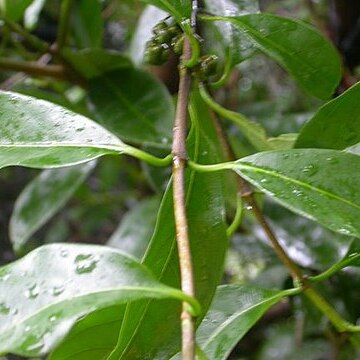Lianas, climbing or twining; branches glabrous to puberulent or hispidulous, becoming weakly angled, often channeled, bluish black to reddish brown. Leaves opposite; petiole 4-6 mm, glabrous, puberulent, or sparsely hirsute; blade drying papery, leathery, or rigid-membranous, adaxially shiny and greenish, pale brown, or brownish black, abaxially matte, greenish, pale brown, or straw-colored, ovate, obovate-lanceolate, obovate-oblong, lanceolate, or linear-lanceolate, 6-9 × 2-3.5 cm, both surfaces glabrous or sometimes hirsute, hispidulous, or puberulent along principal veins, base acute or cuneate, apex acuminate or mucronulate; secondary veins 4 or 5 pairs, usually with pilosulous domatia; stipules fused into a tube, 2-6 mm, scarious to membranous, puberulent, broadly rounded to truncate, on each side with 2 bristles 0.5-1 mm, often caducous. Inflorescence terminal; peduncles 3-11, fasciculate, umbellate, or shortly racemiform, 4-11 mm, puberulent to glabrescent, subtended by 1 to several linear caducous bracts 1-2 mm; heads 1 per peduncle, subglobose to oblate, 1-10 mm in diam., 6-12-flowered. Flowers fused at base or for up to half of hypanthium, biology not noted. Calyx glabrous; limb 0.2-0.8 mm, truncate to denticulate. Corolla white, campanulate, outside glabrous to puberulent; tube 1.2-2 mm, inside densely villous from middle to throat; lobes 4 or 5, narrowly oblong to ligulate, 2.2-3 mm, apically thickened and hooked. Drupecetum subglobose or compressed globose, 7-12 mm in diam., glabrescent. Drupes mostly to fully fused, red, subglobose, 4-5 mm. Fl. Jun-Jul, fr. Oct-Nov.
More
A shrubby climber. The leaves are opposite and shiny. They are sword shaped and 7 cm long. The flowers are in clusters of 6-12 at the ends of branches. The flowers are 1 cm across. They are white and have a scent. The fruit are irregular shaped and 1.5 cm across. They are orange colour.

